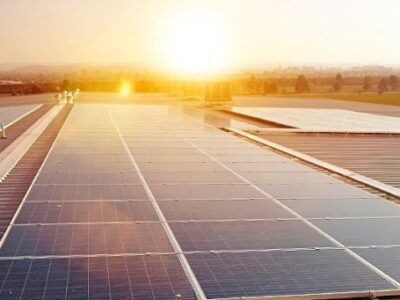The Ray, a Georgia-based living lab for transportation innovation, is leading the way in increasing road safety and sustainability across the United States, starting with a section of rural interstate in Georgia and roads in Austin, Texas. In partnership with 3M Company and Panasonic, the lab is creating and installing solar-powered smart road dots that send data to a cloud-based platform to manage and analyze large amounts of collected information. This information–which includes everything from speed to pollutants–will help transform interstates of the future, making them safer and more efficient.
Beginning in late 2019, when in conjunction with the Georgia Department of Transportation, The Ray re-striped all lanes on 18 miles of Interstate 85 with solar-powered optic technology known as Connected Roads All-Weather Elements. In addition, they installed 2,600 solar panels in the grassy areas around Exit 14, generating a megawatt of clean energy. The striping technology, powered by the solar display, provides visibility during the day and night, in wet or dry conditions. The new stripes also support self-driving vehicles, all the while transmitting constant data to state traffic officials and any networked vehicle. The hope is that this stretch of road will be the first road, but not the last, to be zero carbon, death, waste, and impact.

“We want to enable the roads to join in the conversation,” explained Allie Kelly, Executive Director of The Ray. “These road dots or sensors are solar-powered and give the road some self-awareness by collecting data from the road surface,” Kelly further commented.
The short stretch of Interstate 85 donning road dots has already provided critical information: it produces 70 decibels of noise pollution, and cars that use it emit 250 tons of exhaust daily. The hope is that data gathered from The Ray can make big changes for traffic, safety, and roadway sustainability. By 2022, it is estimated there will be 105 million vehicles on the road that can connect to this type of technology, including first responders and law enforcement. In turn, this will produce the nation’s largest data stream. The city of Atlanta has already jumped on board to expand the technology to 1,700 intersections in the metro area. Leading the way is Peachtree Corners, a suburb of Atlanta; the community is the first city to install solar grids to power electric vehicles.
The Ray’s work now continues in Texas, with hopes that Texans will soon have safer, more efficient roads. The company recently partnered with several Central Texas agencies to further work on sustainability, connected and autonomous vehicle infrastructure. The Texas Department of Transportation Austin District, the Central Texas Regional Mobility Authority, and the city of Austin are working with The Ray on several new technologies, including building solar trees that will also provide shady relief from the area’s long, hot summers.
“In a region like the Southwest, where your summer temperatures commonly exceed 100 degrees, shade is a public safety and a human life safety issue, and it’s also an equity issue,” Kelly continued. “Particularly for people who are heavy users of public transit. Shade can be a serious issue during the summer and fall months and this infrastructure can do double duty. It can utilize solar canopies, solar bus shelters, and solar trees to not only generate clean, carbon-free energy for the Austin area, but we can also create some additional shade,” added The Ray’s Executive Director. The Ray hopes to expand this type of work across the American interstate and city road systems with hopes that right-of-way solar installations and electric vehicle charging stations become part of the ecosystem.
As the data connection network continues to grow, so will the safety implications. For example, a fire engine rushing to a call could ensure that all the traffic lights along its route turn green. The Ray’s work (alongside the work of others) is pivotal as the United States moves toward a sustainable economy. Using thousands of acres of unused freeway right-of-way land for solar can power technologies that will drastically improve driving conditions, traffic, and safety – each an incredible by-product of innovative thinking and the federal government’s new push toward a cleaner, healthier, and more sustainable future.





